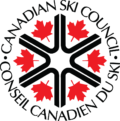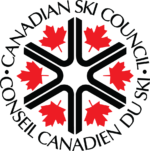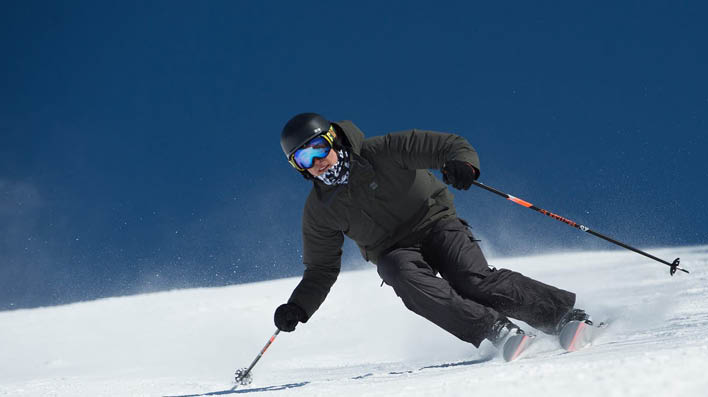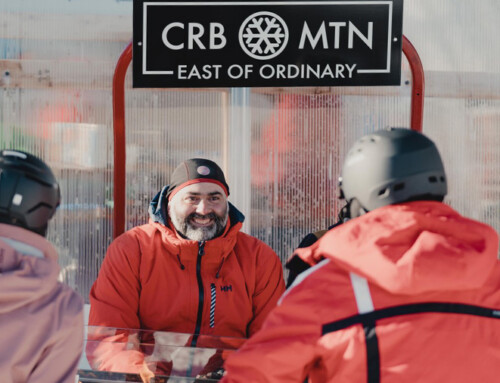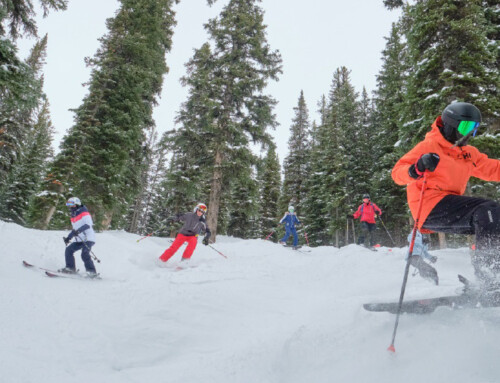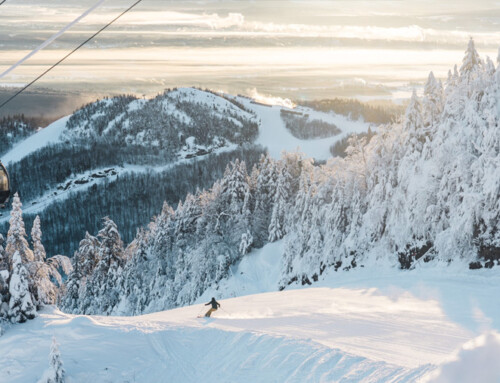This article originally appeared on:
Choosing new downhill skis might feel overwhelming when you’re looking at all the different types of skis (especially if you’re a new skier or are shifting from groomers to powder). But finding your perfect pair gets a lot simpler when you know what to look for and how to narrow down your options.
When you’re choosing downhill skis, here are some things to consider:
- Your skill level: What type of skier are you?
- Where you ski: It’s important to match your skis to the terrain and snow you’re skiing.
- Ski length: Learn what size skis to buy based on your height and weight.
- Ski shape and stiffness: Camber, rocker, sidecut and ski flex affect how skis feel underfoot.
- Choosing skis for kids: Growing kids mean there are a few things to keep in mind.
WHAT SIZE SKIS TO BUY
What size skis do you need? Height, weight and your ability level all determine your ski size. As a general rule, look for a ski length that’s somewhere between your chin and the top of your head when you stand next to the upright skis.
- You’ll likely want shorter skis if you’re new or returning to skiing, if you want to make quick turns, and if you’re not into high speeds.
- Longer skis are for generally for skiers that like to go fast, cover varied terrain, and are looking for twin-tips.
- If you’re skiing powder, you’ll want long, full rocker skis for maximum float.
SKI SIZE CHART
The measurements below are a starting point, not firm rules – it all comes down to personal preference. Heavier and more experienced skiers should size up (longer skis), while lighter skiers should consider sizing down (shorter skis).
| Beginner | Intermediate | Advanced | Expert | |
| Groomed runs (on-piste) |
Your height -10cm | Your height -7cm | Your height -5cm | Your height |
| All-mountain (on- and off-piste) |
Your height -10cm | Your height -5cm | Your height | Your height +5cm |
| Freeride and powder (off-piste) |
Your height -5cm | Your height | Your height | Your height +5cm |
UNDERSTANDING CAMBER, ROCKER, FLEX, AND SIDECUT
Camber and rocker are terms used to describe the way a ski is curved or arched underfoot. It’s easiest to see these shapes when there’s no weight on the ski.

Camber: The tip and tail have contact with the snow when the ski isn’t weighted, and there’s an arch between these points. This helps you hold an edge throughout the arc of your turn, and they generally have softer flex.

Rocker (also called reverse-camber): Gives the ski more of a banana shape. The waist stays on the snow and the tip and/or tail curve or rise upward. This makes powder skiing easier because they give you float, plus they smear a lot more than cambered skis. But they lose performance on harder snow and don’t turn as well since less of the edge is in contact with the snow.

Combined camber and rocker: Results in skis that are somewhat old-time moustache-shaped. They help you hold an edge and give you a bit of float and can give good manoeuvrability since they often feel like a shorter ski underfoot.
SKI SIDECUT AND TURNING RADIUS
If you look at a pair of skis from above, sidecut is the subtle curve of the ski from the tip to the tail. This curve helps creates the turning radius for the ski (the imaginary circle that would be made by completing the arc created by the sidecut) and affects how the skis turn.
Sidecut is calculated from the ski dimensions, which are written as three numbers (for example, 130-100-120mm). The first number is the widest part of the tip or shovel, the second number is the narrowest part of the ski, and the third is the widest part of the tail. The bigger the difference between those numbers, the deeper the sidecut and the shorter the turning radius. Skis with a very small difference between those three measurements are usually designed for powder skiing.
So what does all this mean?
- If you want to carve tight, quick turns on groomed runs, then look for a short turning radius (deeper sidecut) around 16m.
- If you want a versatile ski that helps you make easy turns while still giving you decent stability at speed, look for a medium turning radius between 16m and 22m.
- If you like to charge down runs and make wide turns, look for a large turning radius (shallower sidecut) above 22m to keep you stable.
Over the years, ski companies have experimented with variations of tip widths, tail widths, sidecuts and even reverse sidecuts. Some recent development in ski construction and shaping can even make long skis feel like much shorter ones by bringing the widest parts of the skis (tip and tail) closer to the centre of the ski. As you become a stronger skier, you’ll get to know what ski shape you prefer.
WHAT TO KNOW ABOUT SKI FLEX
Flex refers to how stiff or soft a ski feels for turning. Softer skis (more flex) are great for beginners, lighter weight skiers, and terrain park skiers, as they’re easier to manoeuvre and hold an edge during a turn. Stiffer skis (less flex) give more support and reduce ski chatter at higher speeds. They’re better for advanced skiers who tackle varied terrain.
Check back next week for how to choose skis for kids.
